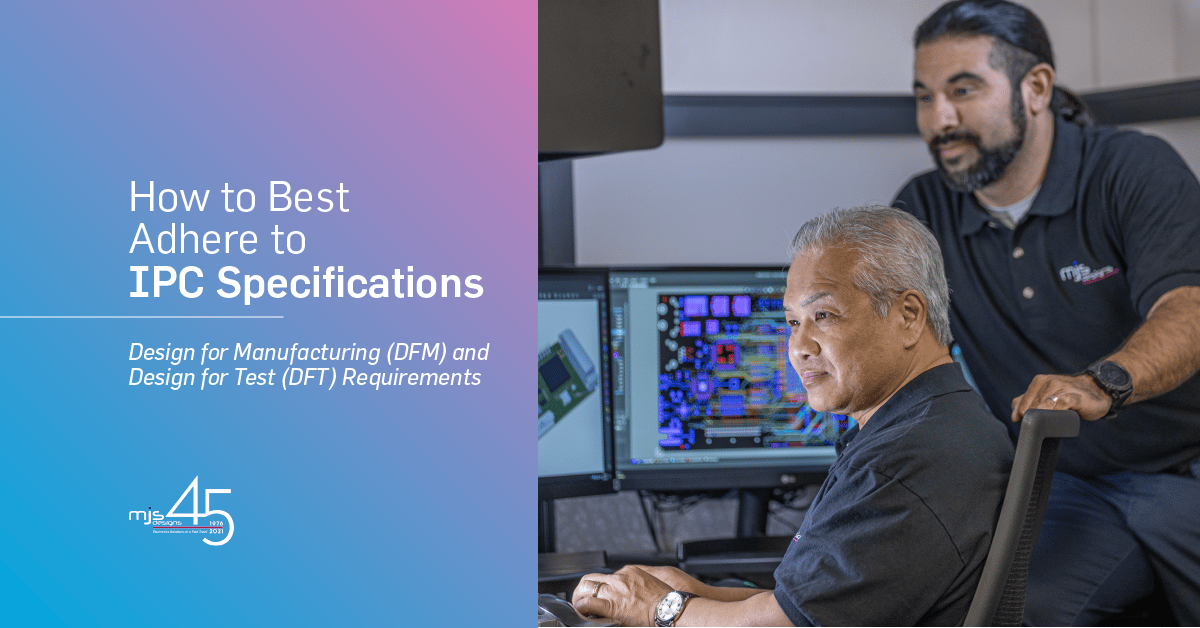Your Printed Circuit Board (PCB) design must be optimized, which takes extensive work and expertise. The right PCB checks are crucial in preparing for the manufacturing stage because improving functionality, ease of manufacturing, and ease of testing is the ultimate goal of all electronics design engineers.
A PCB must be carefully examined for areas that might be improved upon and tested for any problems that can have an impact on manufacturing in order to be optimized for manufacturing.
MJS Designs offers the PCB design and PCB layout services you need.
As your electronics manufacturer service (EMS) provider, our team evaluates the possibility of potential problems that might arise during manufacturing utilizing design for manufacturing (DFM) and design for test (DFT) principles. Additionally, MJS offers PCB design with Valor verification included with every circuit board design. This translates into reduced revision spins and scrap, along with increased product quality.
Assessment of DFM
The following preparatory stages are involved in determining your PCB’s feasibility in terms of DFM:
- Design review—Your design is evaluated or reviewed as soon as our team receives your design data. Our PCB design team will work closely with you to accomplish the most thorough DFM possible.
- Evaluation based on format—If your design utilizes a CAD database format, our engineers will evaluate it first. However, importing will typically be necessary if it uses a different format, which will lengthen the processing time. We will make sure, in advance, to determine which formats are valid.
- Assessment of component availability (if you plan to build with MJS Designs, too)—We will compare the components you have specified and work with manufacturers and distributors to find out the latest availability on the market. Our procurement and engineering team will also handle a review on finding a functional replacement</li
Assessment Criteria for PCB Manufacturability
As part of our PCB design and test services, our highly skilled team will determine the overall manufacturability of your PCB design. Among other things, our team will review the following elements:
Bare Board Analysis
- Drill Analysis—Hole size, aspect ratio, shorts, touching/close holes (49+ checks)
- Signal Layers Analysis—Spacing, slivers, widths, stubs, bottlenecks (78+ checks)
- Power and Ground Plane Analysis—Plane spacing, slivers, widths, bottlenecks (39+ checks)
- Solder Mask Analysis—Pads, coverage, missing clearances, slivers (40+checks)
- Silk Screen Analysis—Hole clearance, SMD clearance, overlaps, reference designators (16+ checks)
- Profile Checks—Board outline, board thickness, aspect ratios
Assembly Analysis
- Fiducial Analysis—Clearance, size, location, side, background (18+ checks)
- Component Analysis—Reference designators, clearances to other components, silk screen, conveyed edge, holes (53+ checks)
- Padstack Analysis—Clearance, toeprints, thermal connections, via-in-pad, solder mask/non-solder mask defined pads, annular ring, pitch (64+ checks)
PCB DFT Recommendations
Our PCB layout services include assessing your design in accordance with DFT recommendations.
Numerous aspects of your PCB design are impacted by testability. Our test analysis will refer to the test specifications you supply while evaluating the testability of your design. Utilizing the knowledge gained from this data, MJS Designs can create a test procedure that adheres to board criteria. To assist us in this planning, you should include particular test points in your schema.
A point to consider when designing for test, MJS Designs uses a fixtureless, extremely flexible flying probe test system. This is optimal for prototype testing and designs going into low to mid-volume manufacturing. Our flying probe test system has the ability to probe part and part leads placed within 0.5mm (20mil, 500µM) of each other. In addition, unmasked vias and parts as small as 0402 can be used as test points so separate test points are not required.
In addition, test points are not required as long as there are access points such as a via or pad. This allows for more real estate on a printed circuit board, if needed, for critical placement. MJS Designs can also accommodate in-circuit system testing, which targets designs that will be used in high-volume manufacturing. Designing for in-circuit testing does require test points.
Understanding the volumes required for your build at the design stage will be an important factor in determining whether test points are required or not.
Let MJS Designs Help You Meet DFM and DFT Requirements
You need a fast, stress-free printed circuit board design experience. MJS Designs will ensure your PCB design fulfills your manufacturing and test expectations.
Contact MJS Designs today to see how we can assist you with your CAD layout and DFM requirements. And ask a team member for a copy of our “Comprehensive Analysis to Validate a Design is Ready for Manufacturing” to learn more about the Valor DFM checks.

